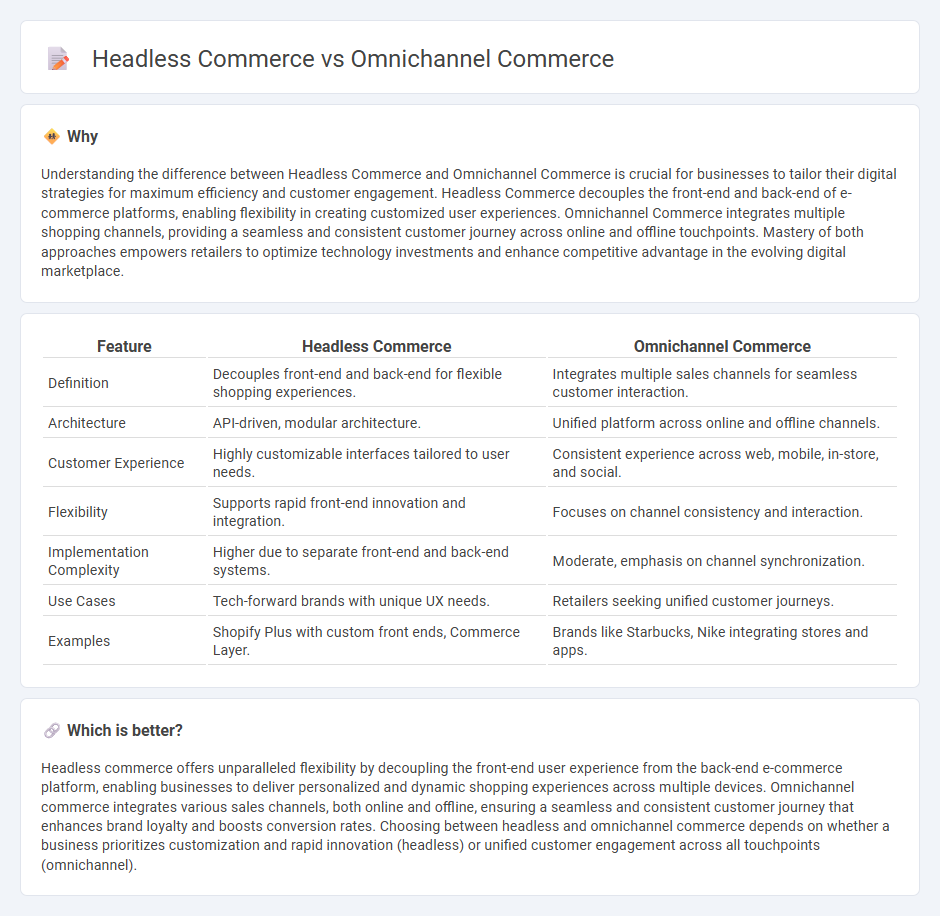
Headless commerce separates the front-end presentation layer from the back-end e-commerce functionality, enabling businesses to deliver customizable shopping experiences across multiple platforms using APIs. Omnichannel commerce integrates various customer touchpoints--including online stores, physical outlets, and mobile apps--into a unified system that ensures seamless interactions and consistent branding. Explore how these innovative strategies can transform your retail operations and enhance customer engagement.
Why it is important
Understanding the difference between Headless Commerce and Omnichannel Commerce is crucial for businesses to tailor their digital strategies for maximum efficiency and customer engagement. Headless Commerce decouples the front-end and back-end of e-commerce platforms, enabling flexibility in creating customized user experiences. Omnichannel Commerce integrates multiple shopping channels, providing a seamless and consistent customer journey across online and offline touchpoints. Mastery of both approaches empowers retailers to optimize technology investments and enhance competitive advantage in the evolving digital marketplace.
Comparison Table
| Feature | Headless Commerce | Omnichannel Commerce |
|---|---|---|
| Definition | Decouples front-end and back-end for flexible shopping experiences. | Integrates multiple sales channels for seamless customer interaction. |
| Architecture | API-driven, modular architecture. | Unified platform across online and offline channels. |
| Customer Experience | Highly customizable interfaces tailored to user needs. | Consistent experience across web, mobile, in-store, and social. |
| Flexibility | Supports rapid front-end innovation and integration. | Focuses on channel consistency and interaction. |
| Implementation Complexity | Higher due to separate front-end and back-end systems. | Moderate, emphasis on channel synchronization. |
| Use Cases | Tech-forward brands with unique UX needs. | Retailers seeking unified customer journeys. |
| Examples | Shopify Plus with custom front ends, Commerce Layer. | Brands like Starbucks, Nike integrating stores and apps. |
Which is better?
Headless commerce offers unparalleled flexibility by decoupling the front-end user experience from the back-end e-commerce platform, enabling businesses to deliver personalized and dynamic shopping experiences across multiple devices. Omnichannel commerce integrates various sales channels, both online and offline, ensuring a seamless and consistent customer journey that enhances brand loyalty and boosts conversion rates. Choosing between headless and omnichannel commerce depends on whether a business prioritizes customization and rapid innovation (headless) or unified customer engagement across all touchpoints (omnichannel).
Connection
Headless commerce enhances omnichannel commerce by decoupling the front-end user interface from the back-end eCommerce platform, allowing seamless integration across multiple channels such as web, mobile, social media, and in-store systems. This architecture enables businesses to deliver consistent, personalized shopping experiences through APIs that connect various touchpoints while maintaining centralized inventory management and order processing. By combining headless commerce with omnichannel strategies, retailers achieve greater flexibility, scalability, and faster deployment of new customer experiences across diverse sales channels.
Key Terms
Customer Experience
Omnichannel commerce integrates multiple sales channels to deliver a seamless and consistent customer experience across online, mobile, and physical stores, enhancing engagement and satisfaction. Headless commerce decouples the front-end presentation layer from the back-end e-commerce functionality, allowing for highly customizable and personalized customer interfaces tailored to specific audience needs. Discover how these innovative commerce models optimize customer experience and drive business growth.
Frontend-Backend Decoupling
Omnichannel commerce integrates multiple customer touchpoints into a unified shopping experience, connecting both frontend and backend systems to ensure consistent data flow. Headless commerce decouples the frontend presentation layer from backend e-commerce functionalities, enabling more flexibility in content delivery and customization across diverse platforms. Explore how these architectures impact scalability and user experience by diving deeper into frontend-backend decoupling strategies.
Integration Channels
Omnichannel commerce integrates multiple sales channels such as physical stores, e-commerce websites, mobile apps, and social media platforms into a seamless customer experience, ensuring consistent messaging and inventory management across all points of contact. Headless commerce decouples the front-end presentation layer from the back-end e-commerce functionality, allowing businesses to customize user interfaces independently while integrating with various third-party services or custom APIs. Explore the differences in integration strategies and how each approach can optimize your sales channels for improved customer engagement.
Source and External Links
Comprehensive Guide for Omnichannel Retail Success for 2025 - Omnichannel commerce is a strategy that integrates all shopping channels into one seamless customer experience, allowing customers to switch effortlessly between digital platforms, mobile apps, and physical stores with consistent pricing and service, improving customer loyalty and operational efficiency.
What Is Omnichannel Retail? How it Works and Examples (2024) - Omnichannel retailing provides a fully integrated commerce experience across all touchpoints--physical stores, online marketplaces, social media, and mobile--meeting the modern customer expectation for seamless, personalized shopping anytime, anywhere, on any device.
What is omnichannel commerce? - Planet - Omnichannel e-commerce employs multiple channels while maintaining consistent customer experience and data continuity, enabling retailers to reach customers wherever they shop and unify interactions across platforms like mobile, social media, and physical locations.
 dowidth.com
dowidth.com